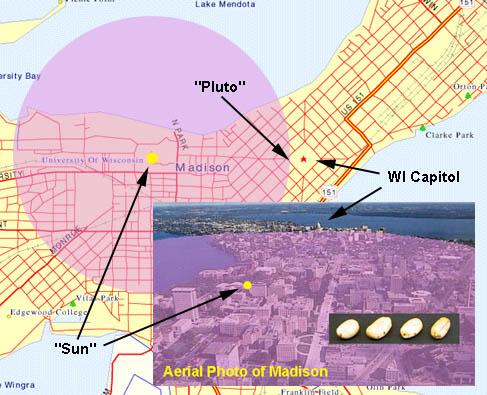Space is
not completely empty, but it is pretty close. And we can use our
scale model of the solar system to give you a feel for this. First, think
of our solar system as a disk. The vast majority of matter in our system
not in the Sun orbits the Sun in a plane. Now, let's treat Pluto as representing
the most distant larger mass object in our solar system. This is not entirely
correct, but it is good enough for our purpose here. As diagrammed below,
the area of our model solar system can now be represented by a purple disk.
It may or may not surprise you to learn that virtually ALL
of the mass in our solar system resides in the Sun. The Sun accounts for
all but about 0.15% of the total matter in our solar system. Of that small
remaining percentage, more than 92% resides in the planets and their moons.
That leaves only a very tiny portion to fill the empty space between the
planets. On the scale of our model system here, the Sun would be about
31kg (or about 70 pounds). That means that after accounting for the sun
and the planets, the residual matter in our model solar system would be
about 3.1g. This is the equivalent of about 4 peanuts shown in the inset
below. Just imagine trying to smear these 4 peanuts evenly over the entire
surface of this purple disk. That is a skimpy peanut butter sandwich. But
guess what....it is actually even skimpier than this! Why? Because
after we consider the sun, the planets, and their moons, the great majority
of the leftover matter is concentrated in the comets, asteroids, and meteorites
of our solar system. The true "empty" space in our model system
(called the interplanetary medium and consisting of dust and gas) would
actually contain the matter of only a tiny portion of a single peanut;
just a mere speck about double the size of a period on this page. Now THAT'S...
Empty!
NOTE: The yellow dot
that denotes the sun is NOT representative of the proper scaled Sun size for
this tour. The correct scaled size of the Sun for this tour is 350 mm. The
correct size model sun is shown here.


